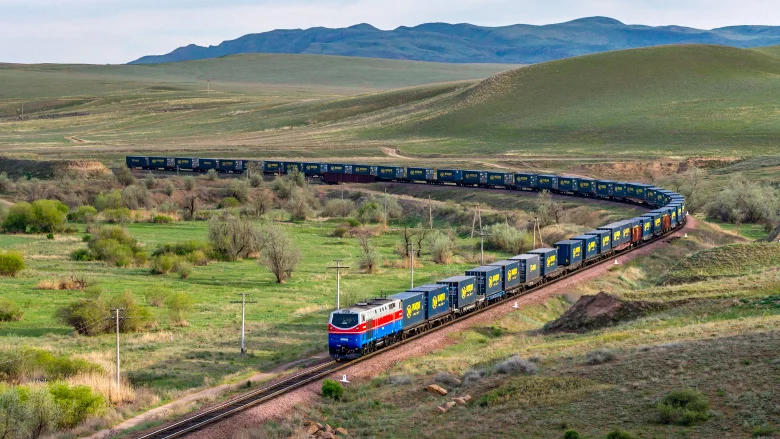BAKU, Azerbaijan, October 18. As global trade patterns continue to evolve, countries and companies are seeking more resilient and efficient logistics solutions. Geopolitical shifts, rising maritime costs, and growing demand for alternative transport corridors have highlighted the strategic importance of overland routes linking Asia and Europe. In this context, the launch of a new multimodal container route from Kashgar, China, to Azerbaijan via Kyrgyzstan, Uzbekistan, and Turkmenistan represents more than a regional infrastructure project - it is a reflection of a broader Eurasian push toward connectivity, economic diversification, and integration.
The first convoy departed Kashgar on October 15, with shipments expected to reach Uzbekistan by October 21 and Turkmenistan by October 24, before continuing toward Azerbaijan and the Caspian region. Beyond moving goods, the corridor represents a strategic realignment in Eurasian logistics, offering an alternative to the traditional Northern Route while strengthening trade flows across Central Asia.
The corridor reflects the growing emphasis among Chinese and Central Asian leaders on deeper economic integration. By diversifying transport chains and improving rail connectivity, the initiative positions the Middle Corridor as a crucial artery for trade between China, Europe, and beyond. It also opens new pathways to South Asia and the Middle East, demonstrating the corridor’s potential to reshape regional commerce and investment flows.
Freight volumes along the Middle Corridor have surged nearly 90% since 2022, underscoring its rising strategic relevance. According to the World Bank, Asian Development Bank, and European Commission, traffic along the corridor could reach 10-11 million tons annually by 2030.
Azerbaijan has emerged as a central hub in this network, linking East and West as well as North and South. With the largest commercial Caspian fleet capable of handling up to 25 million tons per year, nine international airports, and the Baku-Tbilisi-Kars railway ensuring smooth logistics flows, the country has become an indispensable link in the evolving Eurasian transport ecosystem.
Uzbekistan is playing a leading role in modernizing the corridor. In an interview with Trend, the Ministry of Transport has emphasized the country’s active efforts to expand logistics centers and strengthen international railway connections.
"Construction of the China-Kyrgyzstan-Uzbekistan railway is already underway, reflecting its strategic importance for Eurasia. Experts note that the new line could become the shortest route from China to Europe and the Middle East, cutting transport distances by approximately 900 kilometers and reducing delivery times by a week, offering significant economic benefits for participating countries," the source at the ministry said.
President Shavkat Mirziyoyev emphasized at the OTS summit in Gabala that linking the Middle Corridor with the China-Kyrgyzstan-Uzbekistan railway - and eventually the Trans-Afghan corridor - will create a multi-sector strategic transport network across the region. "We fully support the phased development of the Middle Corridor. Our main goal is to ensure its competitiveness and to provide the most favorable conditions for the business community," he said.
Chinese Ambassador to Azerbaijan Lu Mei highlighted the corridor’s broader significance in the context of the Belt and Road Initiative. "Promoting infrastructure connectivity is central to the Belt and Road vision. China and its partners are strengthening regional rail links through the China-Europe Railway Express and the development of the Middle Corridor, including the China-Kyrgyzstan-Uzbekistan route, creating a comprehensive and multidimensional transport network across Eurasia," she noted.
International observers, including Moody’s, have highlighted that strengthening the Middle Corridor benefits not only its core economies - Kazakhstan, Azerbaijan, and Georgia - but also countries such as Uzbekistan and Kyrgyzstan, which gain from improved regional integration. Rail transport offers faster, more reliable, and potentially greener alternatives to maritime routes, giving the corridor a competitive edge and driving a surge in trade flows since 2022.
Secretary-General of the Organization of Turkic States Kubanychbek Omuraliev also recently noted that the corridor’s strategic significance will grow further once the China-Kyrgyzstan-Uzbekistan railway becomes operational. He also stressed the geopolitical and economic importance of the Zangezur Corridor, describing it as a vital piece of a revitalized Silk Road. "Together, these initiatives will create new economic and transit opportunities for our countries," he said.
The Kashgar-originating route is more than a new shipping line; it signals a broader transformation of Eurasian logistics. In a world increasingly focused on efficiency, sustainability, and diversification, the Middle Corridor is emerging as a strategic backbone for regional development. By linking multiple countries through a seamless, multimodal network, it not only strengthens trade connectivity but also fosters economic resilience, investment opportunities, and deeper regional integration - demonstrating that connectivity initiatives today are shaping the commercial and geopolitical landscapes of tomorrow.







